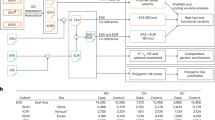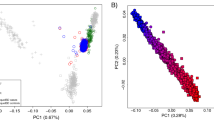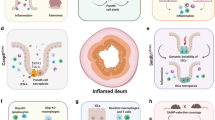Abstract
Crohn disease and ulcerative colitis are two subphenotypes of inflammatory bowel disease (IBD), a complex disorder resulting from gene-environment interaction. We refined our previously defined linkage region for IBD on chromosome 10q23 and used positional cloning to identify genetic variants in DLG5 associated with IBD. DLG5 encodes a scaffolding protein involved in the maintenance of epithelial integrity. We identified two distinct haplotypes with a replicable distortion in transmission (P = 0.000023 and P = 0.004 for association with IBD, P = 0.00012 and P = 0.04 for association with Crohn disease). One of the risk-associated DLG5 haplotypes is distinguished from the common haplotype by a nonsynonymous single-nucleotide polymorphism 113G→A, resulting in the amino acid substitution R30Q in the DUF622 domain of DLG5. This mutation probably impedes scaffolding of DLG5. We stratified the study sample according to the presence of risk-associated CARD15 variants to study potential gene-gene interaction. We found a significant difference in association of the 113A DLG5 variant with Crohn disease in affected individuals carrying the risk-associated CARD15 alleles versus those carrying non-risk-associated CARD15 alleles. This is suggestive of a complex pattern of gene-gene interaction between DLG5 and CARD15, reflecting the complex nature of polygenic diseases. Further functional studies will evaluate the biological significance of DLG5 variants.
This is a preview of subscription content, access via your institution
Access options
Subscribe to this journal
Receive 12 print issues and online access
$259.00 per year
only $21.58 per issue
Buy this article
- Purchase on SpringerLink
- Instant access to full article PDF
Prices may be subject to local taxes which are calculated during checkout



Similar content being viewed by others
References
Hugot, J.P. et al. Association of NOD2 leucine-rich repeat variants with susceptibility to Crohn's disease. Nature 411, 599– 603 (2001).
Ogura, Y. et al. A frameshift mutation in NOD2 associated with susceptibility to Crohn's disease. Nature 411, 603– 606 (2001).
Hampe, J. et al. Association between insertion mutation in NOD2 gene and Crohn's disease in German and British populations. Lancet 357, 1925– 1928 (2001).
Bonen, D.K. & Cho, J.H. The genetics of inflammatory bowel disease. Gastroenterology 124, 521– 536 (2003).
Hampe, J. et al. A genomewide analysis provides evidence for novel linkages in inflammatory bowel disease in a large European cohort. Am. J. Hum. Genet. 64, 808– 816 (1999).
Lu, G. et al. Inflammatory modulation of calcium-activated potassium channels in canine colonic circular smooth muscle cells. Gastroenterology 116, 884– 892 (1999).
Nakamura, H. et al. Identification of a novel human homolog of the Drosophila dlg, P-dlg, specifically expressed in the gland tissues and interacting with p55. FEBS Lett. 433, 63– 67 (1998).
Humbert, P., Russell, S. & Richardson, H. Dlg, Scribble and Lgl in cell polarity, cell proliferation and cancer. Bioessays 25, 542– 553 (2003).
Wakabayashi, M. et al. Interaction of lp-dlg/KIAA0583, a membrane-associated guanylate kinase family protein, with vinexin and beta-catenin at sites of cell-cell contact. J. Biol. Chem. 278, 21709– 21714 (2003).
Shah, G. et al. The cloning, genomic organization and tissue expression profile of the human DLG5 gene. BMC Genomics 3, 6 (2002).
Purmonen, S. et al. HDLG5/KIAA0583, encoding a MAGUK-family protein, is a primary progesterone target gene in breast cancer cells. Int. J. Cancer 102, 1– 6 (2002).
Lennard-Jones, J.E. Classification of inflammatory bowel disease. Scand. J. Gastroenterol. 170 (Suppl), 2– 6 (1989).
Truelove, S.C. & Pena, A.S. Course and prognosis of Crohn's disease. Gut 17, 192– 201 (1976).
Markianos, K., Daly, M.J. & Kruglyak, L. Efficient multipoint linkage analysis through reduction of inheritance space. Am. J. Hum. Genet. 68, 963– 977 (2001).
Daly, M.J. et al. High-resolution haplotype structure in the human genome. Nat. Genet. 29, 229– 232 (2001).
Rioux, J.D. et al. Genetic variation in the 5q31 cytokine gene cluster confers susceptibility to Crohn disease. Nat. Genet. 29, 223– 228 (2001).
Fisher, R.A. Statistical Methods for Research Workers 10th edn. (Oliver and Boyd, London, 1946).
Acknowledgements
We thank all cooperating clinical centers, clinicians, families and individuals with IBD and the German Crohn's and Colitis Foundation (DCCV) for their participation; J. Papp for microsatellite genotyping; A. Andersson, B. Petersen, A. Dellsén, T. Engler, M. van Giezen, Å. Jägervall, T. Kim, N. Tepe and T. Wesse for technical assistance; M. Will and T. Lu for bioinformatics support; F. Friedrichs for assistance in statistical analysis; O. Bengtsson and K. Forsman-Semb for discussions; and M. J. Daly for the Haploview software. This study was supported by the 5th Framework Program of the European Commission and the Federal Ministry of Science and Education through the National Genome Research Network and the Competence Network “Inflammatory Bowel Disease”, and by a coordinated research group of the German Research Foundation (DFGFOR423).
Author information
Authors and Affiliations
Corresponding author
Ethics declarations
Competing interests
B.C., B.M., S.P. and M.L.-F. work for AstraZeneca, a pharmaceutical company, and G.H.W. and D.S. work for Conaris Research Institute AG. These authors have indirect interests in the intellectual property generated here.
Rights and permissions
About this article
Cite this article
Stoll, M., Corneliussen, B., Costello, C. et al. Genetic variation in DLG5 is associated with inflammatory bowel disease. Nat Genet 36, 476–480 (2004). https://doi.org/10.1038/ng1345
Received:
Accepted:
Published:
Issue date:
DOI: https://doi.org/10.1038/ng1345
This article is cited by
-
Distributed transformer for high order epistasis detection in large-scale datasets
Scientific Reports (2024)
-
Identification of microRNAs regulating Escherichia coli F18 infection in Meishan weaned piglets
Biology Direct (2016)
-
Caenorhabditis elegans susceptibility to gut Enterococcus faecalis infection is associated with fat metabolism and epithelial junction integrity
BMC Microbiology (2016)
-
Variant detection and runs of homozygosity in next generation sequencing data elucidate the genetic background of Lundehund syndrome
BMC Genomics (2016)
-
Meta-analysis of associations between DLG5 R30Q and P1371Q polymorphisms and susceptibility to inflammatory bowel disease
Scientific Reports (2016)



